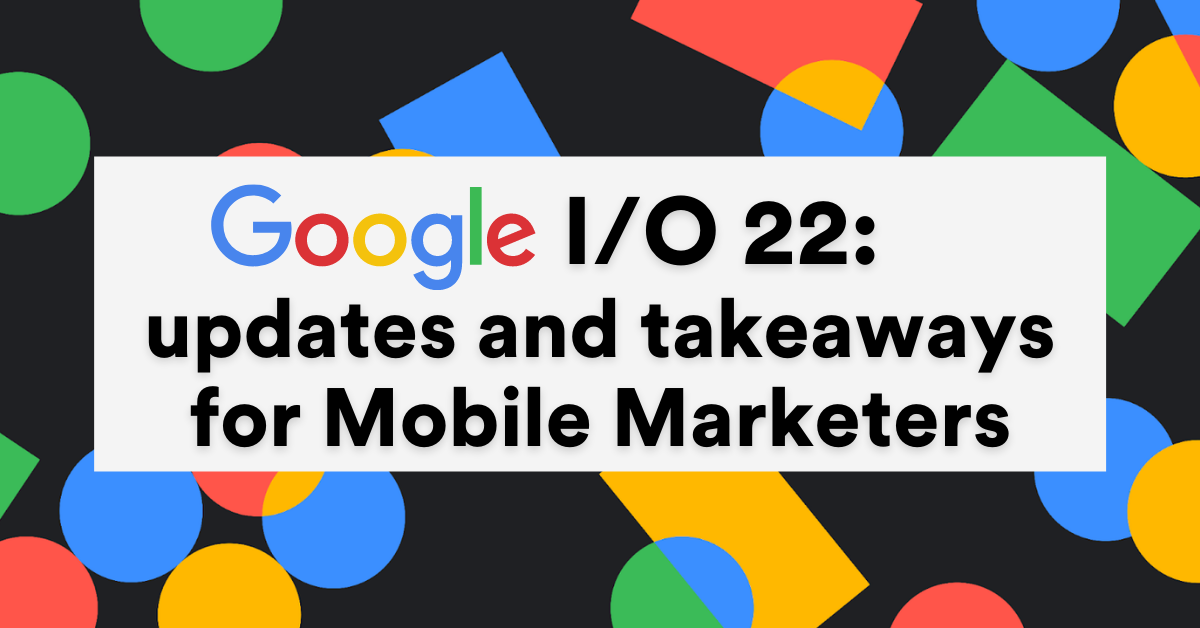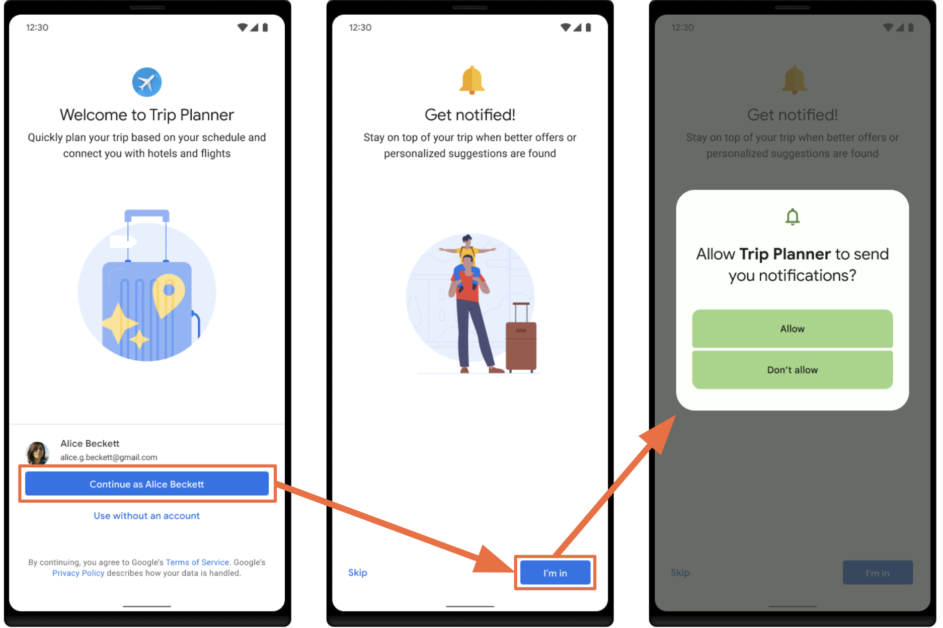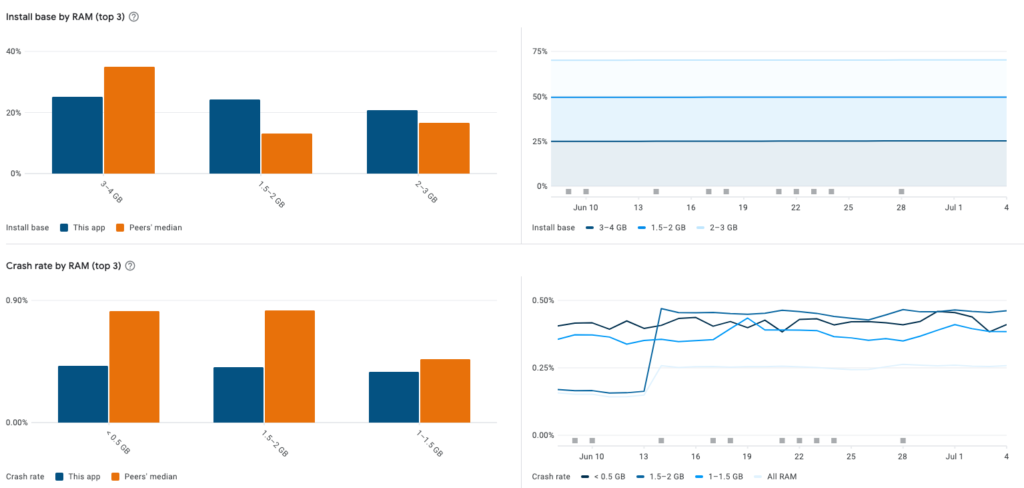The Only Blog Post Mobile Marketers Need To Read About The Google I/O 2022

Reading Time: 7 minutes
With the world slowly getting back on its feet from the COVID-19 pandemic, the Google I/O 2022 was a physical event held at their HQ in Mountain View, California. With lots of exciting updates and announcements, the Google I/O 2022 has many in store for marketers. We break down critical updates that impact marketers and how you can prepare your strategy to stay on top.
Here are the key updates from the Google I/O 2022 for marketers:
Android 13 Round-up
Google launched the second beta for Android 13 at Google I/O, right on schedule. While the beta is available for all Pixel 4 and above, and a few other OEM devices, it’s yet to hit the platform stability milestone scheduled for June 2022 with its third beta. The final release is expected to be in Q3 2022. Here are some vital Android 13 updates and announcements that marketers can prepare for.
Security: Permission update to access customers’ files and multimedia
With Android 13, Google aims to give your customers more control over what personal information they prefer to share (or not) and file permissions they want to grant to apps. Your customers can now select files they want to share with your app instead of giving app permissions to access all of their photos, media, and other content.
Privacy: Asking For Push Notification Opt-in Permission
Before Android 13, apps on Android devices were granted permission by default to send Push Notifications to customers. To prevent customers from feeling overwhelmed with a barrage of Push notifications or unsolicited advertisements and notifications, Android 13 requires apps to ask for permission to send Push Notifications, just like iOS.
How will this work on Android 13?
Newly installed apps will need to ask permission to send Push Notifications. If your app is denied permission to send Push Notifications, you won’t be able to reach your customers via Push Notifications.
But let’s suppose your app already exists on your customer’s device. In this case, you’ll need to ask permission to continue sending Push Notifications when a new app activity launches once the customer updates to Android 13. This is applicable only if your customer hasn’t explicitly opted out of your Push Notifications.
A point to note here is that if the customer dismisses your request for permission, your app will be granted temporary permission till the customer explicitly selects an option in the permission dialog box.

Source: Google
| MoEngage Pro tip for Push Notification opt-in: Convince your customers to turn on your notifications by conveying the value your Push Notifications would provide. You can tell your customer about how your Push Notifications could alert them about the latest discount offers or alerts about upcoming flash sales. Or how your customers can stay updated about essential alerts regarding their KYC status or new products and credit card offers. |
Push Notification Delivery: New Rules For Putting Apps In The Restricted Bucket
Android 9 launched App Standby Buckets, wherein apps were categorized into four buckets that defined what restrictions apps had based on the app’s activity (recency and frequency). This also impacted the apps’ Push Notification deliverability. Android 12 added a 5th bucket called “Restricted”, which has apps that consume exorbitant system resources such as battery life. Apps in this bucket have a significantly lower Push Notification delivery rate.
With Android 13, there are new rules that the Android OS uses to determine if an app should be categorized in the restricted App Standby Bucket. Here are the new rules:
- There has been no app interaction for eight days
- The app solicits too many broadcasts in a 24-hour time interval
- The app drains too much device battery life within 24 hours via several background app activities, among other instances
The good news is that if there’s any app interaction, then your app will be re-categorized into another bucket. App interaction includes a tap on your notification, an action in a widget that belongs to your app, or a media button interaction that may affect a foreground service. For OTT apps, if there’s a visible PiP window or it’s active on the screen, your app is removed from the restricted bucket.
| Key Takeaway For Marketers: It’s important to ensure that your customers interact with your app. This means that you would need to focus on increasing the number of app sessions, app usage frequency, clicks, and even recency. This would also impact the deliverability of your Push Notifications.
How can MoEngage help boost your Push Notification delivery? MoEngage’s industry-first Push Amplification™ technology gives you the highest boost in Push Notification delivery rates. |
Android 13 Personalization Features
Android 13 comes with exciting personalization tools that help Android users connect better with their devices.
Here are some personalization tools that mobile marketers can use to improve their app customer experience and bring in more personalization:
- One of the key features announced during the Google I/O 2022 is multi-language support that now allows Android 13 devices to use apps in a preferred language
- Android 13 supports apps to take on the color theme of the device’s wallpaper. This makes the app experience all the more personal to the device owner and their mobile device
Android Privacy Sandbox
Privacy Sandbox provides new advertising solutions that enhance your customers’’ privacy without risking access to free content and services.
So how does privacy Sandbox impact your marketing efforts?
Google wants the community to share relevant and personalized ads while being able to analyze ad performance but also place a more significant focus on your customers’ privacy. Privacy Sandbox is an effort to be an alternative to third-party cookies in the digital advertising realm on Android. You can read more about Privacy Sandbox here.
Privacy Sandbox is still in the development stage and will likely continue until Q3 of 2022.
Here are the key aspects marketers need to be aware of regarding Privacy Sandbox and advertising solutions:
You can show relevant content and ads primarily in the following ways:
- Information about websites visited will no longer be available across the web as it used to be with third-party cookies. But with Sandbox, topics of interest are categorized into “Topics” based on previous pages visited. Your website visitors also have control over the topics they want to see ads from and even remove or disable them from their profile settings
- Based on the previous website and product visits, your website can inform your visitors’ browsers to request an opportunity to show them ads in the future. Your website can also directly share information such as specific ads you’d like to show your previous website visitors and how much you’re willing to pay to show them an ad. Based on this, when a website visitor lands on a website with ad space, their browser gives a heads-up about what ad might appear
How will Privacy Sandbox help marketers measure their ads’ performance?
Currently, marketers depend on third-party cookies to get a person’s browsing activity data and how they react to ads. Privacy Sandbox will sunset and replace third-party cookies with newer ad performance measuring tools to facilitate ad relevancy and analyze their performance. This way, peoples’ identities are hidden across the websites they visit.
Google’s proposed Attribution Reporting API will enable advertisers to measure their ad campaign performance through data such as conversion counts and values across segments, campaigns, and creative assets for the ad.
Firebase Recap
Every mobile marketer knows the importance of Firebase in reaching and engaging their customers. Here are some key updates you need to know about:
- To add more customization to your specific use case and workflow, you can now use Firebase Extensions, which are pre-packaged code bundles that let you build on top of them. These are chrome plugins that you can use for additional customizations for your use case
- For example, you can set up a trigger to send an email promotion in response to a purchase cancellation
- New Stream extensions allow you to launch a chat in your app and respond to your customers in real-time
- You can also now manage in-app subscriptions with RevenueCat
App Performance Metrics in Real-Time
- The Device Catalog now has a new look and additional data points that help you know more about the devices that are using your app
- The Reach and Devices tool has more capabilities that can now give you more visibility into your app revenue growth metrics

The Reach and Devices Tool | Source: Google
| MoEngage Pro Tip: MoEngage’s Consolidated Campaign stats and the advanced Analytics suite gives you broader and deeper visibility into key metrics that impact your customer engagement campaign performance.
Take your marketing campaigns performance alerts multiple notches above with MoEngage’s Proactive Assistant that shares real-time anomaly detection in your campaign performance along with actionable solutions. |
RCS Chat Updates
Google’s Rich Communication Service Chat (RCS Chat) now brings about a wide array of features to SMS. This includes support for photos, messaging over WiFi, group messaging, and typing indicators (to let you know when someone is typing). Google already provides encryption for one-on-one conversations and expects to roll it out for group messaging by year-end.
You can read more about RCS Chat and why you should invest in this here.
Other Updates For Marketers
There were a few other updates shared during the conference. Some of these were:
- Your customers can now receive a message with In-App Messaging when their payment has been declined and a message that reminds them to update their payment information
- You can now make up to 50 custom store listings
- New Subscription Capabilities now let you sell subscriptions in multiple ways while optimizing operational costs and eliminating double efforts in creating and managing growing products
- Your website visitors can now find relevant context about your website on the Google app
- The yet-to-be-launched My Ad Center would allow Google users more control over their ad privacy and also choose the type of ads they want to see, categories, and brand of their interest, and easily manage their privacy across YouTube, Discover, and Search
- Finding local information got easier with Multisearch Near Me and in the future, use it to glean holistic insights from multiple objects around with Scene Exploration
Conclusion
The Google I/O 2022 packed a punch with exciting launches and improved existing features and product suite. You can read all about the event and deep-dive into the details here.
Android 13, the next version of Android, includes stronger protections for user privacy, improvements for developer productivity, and much more.
We at MoEngage can’t wait to see you implement these updates for your brand. You can subscribe to the MoEngage blog or follow us on LinkedIn for more such posts.
Want to share something about these new features with us? You can tweet it to us.







